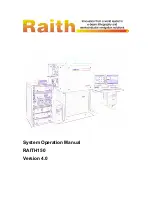
1
Introduction
What is Tuning and Calibration of the MS Detector All About?
14
LTQ XL Getting Started
Thermo Electron Corporation
Tune parameters are instrument parameters whose values can vary with the
type of experiment. For example, if your experiment requires quantitative
data on one or more particular ions, you need to tune the MS detector with
your analyte if you change any one of the parameters specific to the
experiment or analyte.
Automatic and semi-automatic tuning procedures (including optimizing the
collision energy) require that you introduce calibration solution, or a tuning
solution of your analyte of interest, into the MS detector at a steady rate in
either of two ways:
• Introduce the solution directly from the syringe pump. See
the Syringe Pump for Tuning and Calibration
and Calibrating Automatically in the ESI/MS Mode”
• Introduce the sample from the syringe pump into the effluent of the LC
by using a Tee union. See
Setting Up to Introduce Sample by Syringe
Pump into Solvent Flow from an LC
Use the first method for tuning if you intend to use an experiment type at a
low flow rate involving the syringe pump. The second method is useful if
you intend to use an experiment type at a higher flow rate involving the LC.
However, the second method of introduction puts a comparatively large
amount of analyte into the MS detector. Therefore, before you can perform
an analytical run to analyze for the analyte, you might need to clean the API
spray shield.
In most cases, you can use the tune you obtain from the automatic or
semi-automatic tuning procedures for your analytical experiments.
However, for some applications, you might need to tune several MS detector
parameters. In that case, you would tune manually. With the manual tuning
process, you introduce a tuning solution at a steady flow rate.
CAUTION
Do not use the calibration solution at flow rates above 10
μ
L/min. Ultramark 1621 can contaminate your system at high
concentrations.
Note
The most important parameters that affect the signal quality
during ESI/MS operation are the ion transfer capillary temperature, tube
lens voltage, gases, and solution flow rate. For optimum sensitivity, tune
with the instrument in the same operational mode as the mode you use
for the analytical experiment.
















































